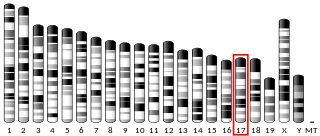Retinal guanylyl cyclase 2 also known as guanylate cyclase F (GUCY2F) is a protein that in humans is encoded by the GUCY2F gene. [5]
Retinal guanylyl cyclase 2 also known as guanylate cyclase F (GUCY2F) is a protein that in humans is encoded by the GUCY2F gene. [5]
The protein encoded by this gene is a guanylyl cyclase found predominantly in photoreceptors in the retina. The encoded protein is thought to be involved in resynthesis of cGMP after light activation of the visual signal transduction cascade, allowing a return to the dark state. This protein is a single-pass type I membrane protein. [5]
Defects in this gene may be a cause of X-linked retinitis pigmentosa. [5]

Guanylate cyclase is a lyase enzyme that converts guanosine triphosphate (GTP) to cyclic guanosine monophosphate (cGMP) and pyrophosphate:

Bert Vogelstein is director of the Ludwig Center, Clayton Professor of Oncology and Pathology and a Howard Hughes Medical Institute investigator at The Johns Hopkins Medical School and Sidney Kimmel Comprehensive Cancer Center. A pioneer in the field of cancer genomics, his studies on colorectal cancers revealed that they result from the sequential accumulation of mutations in oncogenes and tumor suppressor genes. These studies now form the paradigm for modern cancer research and provided the basis for the notion of the somatic evolution of cancer.

Guanylate cyclase 2C, also known as guanylyl cyclase C (GC-C), intestinal guanylate cyclase, guanylate cyclase-C receptor, or the heat-stable enterotoxin receptor (hSTAR) is an enzyme that in humans is encoded by the GUCY2C gene.

Recoverin is a 23 kilodalton (kDa) neuronal calcium-binding protein that is primarily detected in the photoreceptor cells of the eye. It plays a key role in the inhibition of rhodopsin kinase, a molecule which regulates the phosphorylation of rhodopsin. A reduction in this inhibition helps regulate sensory adaptation in the retina, since the light-dependent channel closure in photoreceptors causes calcium levels to decrease, which relieves the inhibition of rhodopsin kinase by calcium-bound recoverin, leading to a more rapid inactivation of metarhodopsin II.

Victor E. Velculescu is a Professor of Oncology and Co-Director of Cancer Biology at Johns Hopkins University School of Medicine. He is internationally known for his discoveries in genomics and cancer research.

Retinal guanylyl cyclase 1 also known as guanylate cyclase 2D, retinal is an enzyme that in humans is encoded by the GUCY2D gene.

Natriuretic peptide receptor A/guanylate cyclase A , also known as NPR1, is an atrial natriuretic peptide receptor. In humans it is encoded by the NPR1 gene.

Rod cGMP-specific 3',5'-cyclic phosphodiesterase subunit beta is the beta subunit of the protein complex PDE6 that is encoded by the PDE6B gene. PDE6 is crucial in transmission and amplification of visual signal. The existence of this beta subunit is essential for normal PDE6 functioning. Mutations in this subunit are responsible for retinal degeneration such as retinitis pigmentosa or congenital stationary night blindness.

Guanylyl cyclase-activating protein 1 is an enzyme that in humans is encoded by the GUCA1A gene.

Homeobox protein OTX2 is a protein that in humans is encoded by the OTX2 gene.

Guanine nucleotide-binding protein G(t) subunit alpha-1 is a protein that in humans is encoded by the GNAT1 gene.

Cyclic nucleotide-gated channel alpha 1, also known as CNGA1, is a human gene encoding an ion channel protein. Heterologously expressed CNGA1 can form a functional channel that is permeable to calcium. In rod photoreceptors, however, CNGA1 forms a heterotetramer with CNGB1 in a 3:1 ratio. The addition of the CNGB1 channel imparts altered properties including more rapid channel kinetics and greater cAMP-activated current. When light hits rod photoreceptors, cGMP concentrations decrease causing rapid closure of CNGA1/B1 channels and, therefore, hyperpolarization of the membrane potential.

Guanylate cyclase soluble subunit beta-1 is an enzyme that in humans is encoded by the GUCY1B3 gene.

Rod cGMP-specific 3',5'-cyclic phosphodiesterase subunit alpha is an enzyme that in humans is encoded by the PDE6A gene.

Serine/threonine-protein phosphatase with EF-hands 1 is an enzyme that in humans is encoded by the PPEF1 gene.

Guanylyl cyclase-activating protein 2 is an enzyme that in humans is encoded by the GUCA1B gene. Alternative names:

Guanylate cyclase soluble subunit alpha-3 is an enzyme that in humans is encoded by the GUCY1A3 gene.

Endosialin is a protein that in humans is encoded by the CD248 gene.

Guanylate cyclase soluble subunit alpha-2 is an enzyme that in humans is encoded by the GUCY1A2 gene.

Plexin domain-containing protein 1 is a protein that in humans is encoded by the PLXDC1 gene.
This article incorporates text from the United States National Library of Medicine, which is in the public domain.